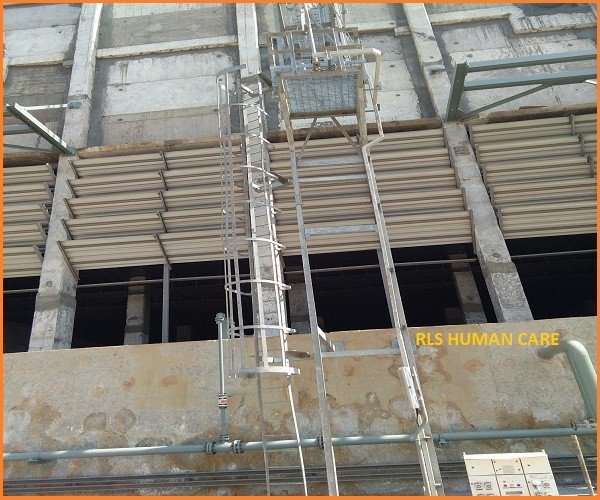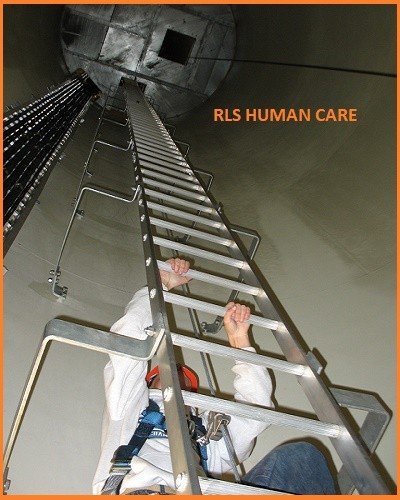Ladders may be classified under two broad categories, the portable and the fixed. Since the portable ladder is a rather hazardous piece of equipment, every effort should be made, wherever possible to replace it with fixed stairs, fixed ladder, scaffolding, or any other suitable arrangement. Not using ladders where required is a common cause of serious accidents. Men climb on machines, equipment, boxes, barrels, etc.
Ladders should rest on firm ground and its top should extend at least 1 meter above the place of landing.
Contents
Step (Swing back) ladders and folding trestle ladders:
In situations where there is no suitable facility to lean the ladders, such a ladder should be the right choice. Step (Swing back) ladders are generally provided with a convenient platform and a handrail at the top.

Fixed ladders
Where the length of a fixed ladder exceeds 9 meters it is necessary to provide a crinoline for ensuring the safety of the user. Alternatively, a suitable fall arrester should be used. In the fall arrester aside runs smoothly up and down a steel cable fitted along with the center of the ladder. The slide is attached to the user’s belt by a chain. The slide moves up and down the cable as long as the user climbs or descends at the normal speed. If the user falls, the abrupt pull on the slide causes it to catch on the cable and thus the fall is arrested (controlled).

Transport of ladders
Ladders should be carried always with the leading end at least 2 meters above the ground. Long and heavy ladders should be carried by two or more persons. The ladder is safest and easiest to climb when it is at an angle of about 75 degrees to the horizontal, i.e to a slope of about four vertical to one horizontal.
CLICK HERE FOR WORK AT HEIGHT SAFETY
The portable ladder should not be more than 20 feet long.
Non-slip devices for ladder feet: Slipping off the feet of the ladder can be prevented by fixing non-slip ladder shoes to the stiles. They are of fixed or pivoted type, and the soles may be of rubber, cork, braided rope, leather, gelt or lead. Steel spikes or pointed ferrules fixed to the feet of the stiles, also serve as ladder shoes. Lashing the ladder by side guys should be resorted to where no anchorage is available near the top. A very long ladder should also be tied by guy ropes.
Climbing ladders
A person ascending or descending a ladder should always face the ladder. Facing away from the ladder while descending is a dangerous practice.
When climbing or descending a ladder, the rungs should be held firmly hand over hand. It is easier and hence safer for a person to cling on to rungs than to Castile, in case the foot slip. However, in the case of fixed ladders with wide steps and narrow stiles, it is safer to hold the stiles.

Tools should be carried in a holster attached to a belt or in a tool bag or box slung from a strap over the shoulder. The safest procedure is to hoist or lower the tools and materials by a rope.
There is greater danger of slipping when the footwear or rungs are wet, dirty or covered with paints, plaster, grease or oil. Therefore they should be cleaned.
Work on ladders
Working from the top of a single ladder can be particularly dangerous when the job requires the use of both hands. The safer way is to stand on a rung about a meter below the top rung to which safety belt is attached. The equilibrium of the ladder can be easily upset if one leans sideways.
Misuse of the ladder: Use of trestle ladders as single ladders can easily lead to an accident. Crawling ladders used over roofs are not designed for use as ordinary single ladders. They should be supported throughout their length.
Likewise, single ladders are not designed to be used in a horizontal position as bridges or platforms. A door should be closed before placing the ladder over it. Do not use a metal ladder near live electric lines. Use the ladder by facing toward it and not otherwise.
The ladder should not be put on the aisle. Do not rest it on the drum, machine, boxes, etc. to reach a height. Falling in cracks and faults or covering up repaired portions with paints and putty is a dangerous practice as the potential weak points are then hidden and cannot be detected during inspections. Ladders should not be allowed to lie in the open exposed to sun and the weather.






Its good topic but there are many more details can be added in the ladders safety topic such as ladder angle, painted ladders prevention requirement and wooden ladders etc.